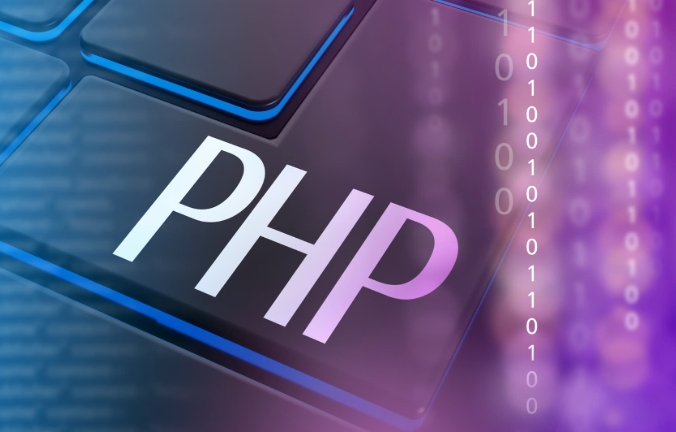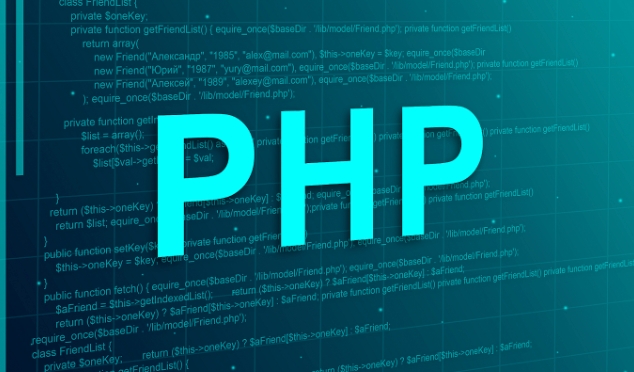 Backend Development
Backend Development
 PHP Tutorial
PHP Tutorial
 PHP beginner guide: Detailed explanation of local environment configuration
PHP beginner guide: Detailed explanation of local environment configuration
PHP beginner guide: Detailed explanation of local environment configuration
Jun 27, 2025 am 02:09 AMTo set up a PHP development environment, you need to select the appropriate tools and install the configuration correctly. ①The most basic PHP local environment requires three components: the web server (Apache or Nginx), PHP itself and database (such as MySQL/MariaDB); ② It is recommended that beginners use integration packages such as XAMPP or MAMP, which simplify the installation process. XAMPP is suitable for Windows and macOS. After installation, the project files are placed in the htdocs directory and accessed through localhost; ③MAMP is suitable for Mac users and supports convenient switching of PHP versions, but the free version has limited functions; ④ Advanced users can manually install them by Homebrew, and can achieve more flexible control in macOS/Linux systems through terminal commands; ⑤ Common precautions include ensuring that the port is not occupied, the PHP version matches project requirements, enabling necessary extensions, and setting permissions correctly. After the configuration is completed, the environment usually runs stably, which facilitates subsequent development and problem investigation.

Setting up a PHP development environment might seem daunting if you're just starting out, but it's actually straightforward once you understand the key components involved. You don't need to overcomplicate things—just get a few tools working together and you're good to go.

What do you really need for a PHP local environment?
A basic PHP setup requires three main pieces: a web server, PHP itself, and a database. The most common combo is Apache (or Nginx), PHP, and MySQL/MariaDB. These are often packaged together in tools that simplify installation.

- Apache or Nginx : Handles HTTP requests and serves your PHP files.
- PHP : Processes the actual PHP code and returns HTML to the browser.
- MySQL / MariaDB : Stores data for dynamic websites like blogs or user systems.
You can install each separately, but beginners usually benefit more from using an all-in-one package.
Option 1: Use XAMPP (great for Windows and macOS)
XAMPP is one of the easiest ways to get started. It bundles Apache, PHP, MySQL, and phpMyAdmin—all in one installer.

How to set it up:
- Download XAMPP from the official site (make sure it matches your OS).
- Run the installer and choose where to install it (default is fine).
- Start Apache and MySQL from the XAMPP control panel.
- Put your PHP files into the
htdocsfolder inside the XAMPP directory. - Access them via
http://localhost/your-folder-name.
A common mistake is trying to run XAMPP on a system where port 80 is already taken (like by Skype or IIS). If Apache doesn't start, check which app is using port 80 and either stop it or change Apache's port in the config.
Option 2: MAMP (another solid choice, especially for Mac users)
MAMP works similarly to XAMPP but is known for being smoother on macOS. It also lets you easily switch between PHP versions.
Key points when using MAMP:
- The default document root is
htdocsunder the MAMP folder, not system-wide/Applications. - To use localhost paths like
http://localhost:8888/myproject, place your project in the correct htdocs folder. - You can change the ports if needed (eg, to avoid using 8888 and go straight to port 80).
One thing to note: MAMP Free version has some limitations, so if you want advanced features like command-line access to PHP, you may want to look into the Pro version or another method.
Option 3: Manual setup with Homebrew (for macOS/Linux users who like control)
If you prefer more control and are comfortable with the terminal, installing PHP and related tools manually can be rewarding.
Basic steps:
- Install Homebrew if you haven't already (
/bin/bash -c "$(curl -fsSL https://raw.githubusercontent.com/Homebrew/install/HEAD/install.sh)") - Install PHP:
brew install php - Install MySQL:
brew install mysql - Start services:
brew services start mysqlandbrew services start php - Set up your document root and configure
php.inias needed
This gives you a cleaner, more modern setup, but troubleshooting issues like path problems or missing extensions can take time if you're new.
A few gotchas to watch out for
- Make sure your PHP version matches what your project needs. Some older projects won't work well with PHP 8.
- Extensions like
mysqli,pdo, andmbstringare commonly needed—check they're enabled inphp.ini. - Permissions matter, especially on Linux/macOS. Your web server must have read access to your project files.
Basically that's it. Once everything is running, you'll barely think about the environment again unless something breaks. And even then, knowing how each piece fits together make debugging much easier.
The above is the detailed content of PHP beginner guide: Detailed explanation of local environment configuration. For more information, please follow other related articles on the PHP Chinese website!

Hot AI Tools

Undress AI Tool
Undress images for free

Undresser.AI Undress
AI-powered app for creating realistic nude photos

AI Clothes Remover
Online AI tool for removing clothes from photos.

Clothoff.io
AI clothes remover

Video Face Swap
Swap faces in any video effortlessly with our completely free AI face swap tool!

Hot Article

Hot Tools

Notepad++7.3.1
Easy-to-use and free code editor

SublimeText3 Chinese version
Chinese version, very easy to use

Zend Studio 13.0.1
Powerful PHP integrated development environment

Dreamweaver CS6
Visual web development tools

SublimeText3 Mac version
God-level code editing software (SublimeText3)
 PHP calls AI intelligent voice assistant PHP voice interaction system construction
Jul 25, 2025 pm 08:45 PM
PHP calls AI intelligent voice assistant PHP voice interaction system construction
Jul 25, 2025 pm 08:45 PM
User voice input is captured and sent to the PHP backend through the MediaRecorder API of the front-end JavaScript; 2. PHP saves the audio as a temporary file and calls STTAPI (such as Google or Baidu voice recognition) to convert it into text; 3. PHP sends the text to an AI service (such as OpenAIGPT) to obtain intelligent reply; 4. PHP then calls TTSAPI (such as Baidu or Google voice synthesis) to convert the reply to a voice file; 5. PHP streams the voice file back to the front-end to play, completing interaction. The entire process is dominated by PHP to ensure seamless connection between all links.
 How to use PHP to build social sharing functions PHP sharing interface integration practice
Jul 25, 2025 pm 08:51 PM
How to use PHP to build social sharing functions PHP sharing interface integration practice
Jul 25, 2025 pm 08:51 PM
The core method of building social sharing functions in PHP is to dynamically generate sharing links that meet the requirements of each platform. 1. First get the current page or specified URL and article information; 2. Use urlencode to encode the parameters; 3. Splice and generate sharing links according to the protocols of each platform; 4. Display links on the front end for users to click and share; 5. Dynamically generate OG tags on the page to optimize sharing content display; 6. Be sure to escape user input to prevent XSS attacks. This method does not require complex authentication, has low maintenance costs, and is suitable for most content sharing needs.
 How to use PHP combined with AI to achieve text error correction PHP syntax detection and optimization
Jul 25, 2025 pm 08:57 PM
How to use PHP combined with AI to achieve text error correction PHP syntax detection and optimization
Jul 25, 2025 pm 08:57 PM
To realize text error correction and syntax optimization with AI, you need to follow the following steps: 1. Select a suitable AI model or API, such as Baidu, Tencent API or open source NLP library; 2. Call the API through PHP's curl or Guzzle and process the return results; 3. Display error correction information in the application and allow users to choose whether to adopt it; 4. Use php-l and PHP_CodeSniffer for syntax detection and code optimization; 5. Continuously collect feedback and update the model or rules to improve the effect. When choosing AIAPI, focus on evaluating accuracy, response speed, price and support for PHP. Code optimization should follow PSR specifications, use cache reasonably, avoid circular queries, review code regularly, and use X
 PHP creates a blog comment system to monetize PHP comment review and anti-brush strategy
Jul 25, 2025 pm 08:27 PM
PHP creates a blog comment system to monetize PHP comment review and anti-brush strategy
Jul 25, 2025 pm 08:27 PM
1. Maximizing the commercial value of the comment system requires combining native advertising precise delivery, user paid value-added services (such as uploading pictures, top-up comments), influence incentive mechanism based on comment quality, and compliance anonymous data insight monetization; 2. The audit strategy should adopt a combination of pre-audit dynamic keyword filtering and user reporting mechanisms, supplemented by comment quality rating to achieve content hierarchical exposure; 3. Anti-brushing requires the construction of multi-layer defense: reCAPTCHAv3 sensorless verification, Honeypot honeypot field recognition robot, IP and timestamp frequency limit prevents watering, and content pattern recognition marks suspicious comments, and continuously iterate to deal with attacks.
 How to use PHP to combine AI to generate image. PHP automatically generates art works
Jul 25, 2025 pm 07:21 PM
How to use PHP to combine AI to generate image. PHP automatically generates art works
Jul 25, 2025 pm 07:21 PM
PHP does not directly perform AI image processing, but integrates through APIs, because it is good at web development rather than computing-intensive tasks. API integration can achieve professional division of labor, reduce costs, and improve efficiency; 2. Integrating key technologies include using Guzzle or cURL to send HTTP requests, JSON data encoding and decoding, API key security authentication, asynchronous queue processing time-consuming tasks, robust error handling and retry mechanism, image storage and display; 3. Common challenges include API cost out of control, uncontrollable generation results, poor user experience, security risks and difficult data management. The response strategies are setting user quotas and caches, providing propt guidance and multi-picture selection, asynchronous notifications and progress prompts, key environment variable storage and content audit, and cloud storage.
 PHP realizes commodity inventory management and monetization PHP inventory synchronization and alarm mechanism
Jul 25, 2025 pm 08:30 PM
PHP realizes commodity inventory management and monetization PHP inventory synchronization and alarm mechanism
Jul 25, 2025 pm 08:30 PM
PHP ensures inventory deduction atomicity through database transactions and FORUPDATE row locks to prevent high concurrent overselling; 2. Multi-platform inventory consistency depends on centralized management and event-driven synchronization, combining API/Webhook notifications and message queues to ensure reliable data transmission; 3. The alarm mechanism should set low inventory, zero/negative inventory, unsalable sales, replenishment cycles and abnormal fluctuations strategies in different scenarios, and select DingTalk, SMS or Email Responsible Persons according to the urgency, and the alarm information must be complete and clear to achieve business adaptation and rapid response.
 Beyond the LAMP Stack: PHP's Role in Modern Enterprise Architecture
Jul 27, 2025 am 04:31 AM
Beyond the LAMP Stack: PHP's Role in Modern Enterprise Architecture
Jul 27, 2025 am 04:31 AM
PHPisstillrelevantinmodernenterpriseenvironments.1.ModernPHP(7.xand8.x)offersperformancegains,stricttyping,JITcompilation,andmodernsyntax,makingitsuitableforlarge-scaleapplications.2.PHPintegrateseffectivelyinhybridarchitectures,servingasanAPIgateway
 PHP integrated AI speech recognition and translator PHP meeting record automatic generation solution
Jul 25, 2025 pm 07:06 PM
PHP integrated AI speech recognition and translator PHP meeting record automatic generation solution
Jul 25, 2025 pm 07:06 PM
Select the appropriate AI voice recognition service and integrate PHPSDK; 2. Use PHP to call ffmpeg to convert recordings into API-required formats (such as wav); 3. Upload files to cloud storage and call API asynchronous recognition; 4. Analyze JSON results and organize text using NLP technology; 5. Generate Word or Markdown documents to complete the automation of meeting records. The entire process needs to ensure data encryption, access control and compliance to ensure privacy and security.





